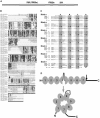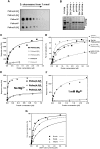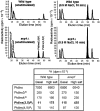Svp1p defines a family of phosphatidylinositol 3,5-bisphosphate effectors
- PMID: 15103325
- PMCID: PMC404323
- DOI: 10.1038/sj.emboj.7600203
Svp1p defines a family of phosphatidylinositol 3,5-bisphosphate effectors
Abstract
Phosphatidylinositol 3,5-bisphosphate (PtdIns(3,5)P2), made by Fab1p, is essential for vesicle recycling from vacuole/lysosomal compartments and for protein sorting into multivesicular bodies. To isolate PtdIns(3,5)P2 effectors, we identified Saccharomyces cerevisiae mutants that display fab1delta-like vacuole enlargement, one of which lacked the SVP1/YFR021w/ATG18 gene. Expressed Svp1p displays PtdIns(3,5)P2 binding of exquisite specificity, GFP-Svp1p localises to the vacuole membrane in a Fab1p-dependent manner, and svp1delta cells fail to recycle a marker protein from the vacuole to the Golgi. Cells lacking Svp1p accumulate abnormally large amounts of PtdIns(3,5)P2. These observations identify Svp1p as a PtdIns(3,5)P2 effector required for PtdIns(3,5)P2-dependent membrane recycling from the vacuole. Other Svp1p-related proteins, including human and Drosophila homologues, bind PtdIns(3,5)P2 similarly. Svp1p and related proteins almost certainly fold as beta-propellers, and the PtdIns(3,5)P2-binding site is on the beta-propeller. It is likely that many of the Svp1p-related proteins that are ubiquitous throughout the eukaryotes are PtdIns(3,5)P2 effectors. Svp1p is not involved in the contributions of FAB1/PtdIns(3,5)P2 to MVB sorting or to vacuole acidification and so additional PtdIns(3,5)P2 effectors must exist.
Figures








References
-
- Baginski ES, Foa PP, Zak B (1967) Microdetermination of inorganic phosphate, phospholipids, and total phosphate in biologic materials. Clin Chem 13: 326–332 - PubMed
-
- Barth H, Meiling-Wesse K, Epple UD, Thumm M (2001) Autophagy and the cytoplasm to vacuole targeting pathway both require Aut10p. FEBS Lett 508: 23–28 - PubMed
-
- Barth H, Meiling-Wesse K, Epple UD, Thumm M (2002) Mai1p is essential for maturation of proaminopeptidase I but not for autophagy. FEBS Lett 512: 173–179 - PubMed
Publication types
MeSH terms
Substances
Grants and funding
LinkOut - more resources
Full Text Sources
Other Literature Sources
Molecular Biology Databases

